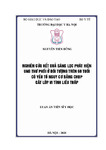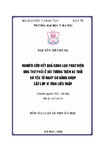
Please use this identifier to cite or link to this item:
http://dulieuso.hmu.edu.vn/handle/hmu/1993| Title: | Nghiên cứu kết quả sàng lọc phát hiện ung thư phổi ở đối tượng trên 60 tuổi có yếu tố nguy cơ bằng chụp cắt lớp vi tính liều thấp |
| Authors: | Nguyễn Tiến, Dũng |
| Advisor: | GS.TS. Ngô Quý, Châu PGS.TS. Nguyễn Quốc, Dũng |
| Keywords: | 62720144;Nội hô hấp |
| Abstract: | Những kết luận mới của luận án: . 1. Về kết quả sàng lọc phát hiện ung thư phổi bằng chụp cắt lớp vi tính liều thấp. Đặc điểm của đối tượng nghiên cứu: tuổi trung bình là 72,7 ± 6,12 tuổi, trong đó tuổi trung bình của nhóm mắc ung thư phổi là 73,3 ± 6,42. Triệu chứng lâm sàng: không có triệu chứng (61,9%), triệu chứng còn lại gồm: ho khan, đau ngực, khó thở... Kết quả chụp sàng lọc: nốt không canxi hóa (10%), nốt canxi hóa (7,5%) và chụp bình thường (80,2%). Đa phần có 1 nốt mờ (94,8%), còn lại 5,2% có 2 và 3 nốt mờ. Nốt mờ trung tâm (7,7%) và nốt mờ ngoại vi (92,3%) và vị trí thường gặp nốt mờ nhất là thùy trên 2 phổi (46,2%). Kích thước tổn thương từ 8-20 mm chiếm nhiều nhất (35,9%), nhóm trên 30 mm chiếm ít nhất (5,1%), kích thước càng lớn nguy cơ ác tính càng cao. Nốt mờ bờ tròn nhẵn (74,3%), tua gai (15,4%) và hình ảnh tua gai nguy cơ ác tính cao. Đa phần nốt đặc hoàn toàn là ung thư (77,8%), nốt đặc không hoàn toàn là ung thư (22,2%).. Kết quả áp dụng quy trình theo dõi chẩn đoán các nốt mờ ở phổi của Mayo Clinic sau 3-6 tháng. Kết quả chụp cắt lớp vi tính theo dõi: nhóm nốt mờ ≤4mm, sau 6 tháng hầu như không thấy nốt hoặc không thay đổi kích thước, các nốt >4 và ≤8mm sau 3 tháng hầu như không thay đổi kích thước hoặc không thấy nốt, chỉ có 1 trường hợp tăng kích thước sau 6 tháng (kết quả viêm mạn tính). Như vậy nhóm ≤8mm khả năng lành tính cao, còn nhóm >8mm thay đổi kích thước nhiều nhất với 4 trường hợp tăng kích thước sau 3 tháng. Phương thức tiếp cận nốt mờ: sinh thiết xuyên thành ngực là phương pháp tiếp cận nốt mờ chủ yếu để chẩn đoán mô bệnh học, kết quả chẩn đoán xác định 10/19 ca. Phương pháp phẫu thuật chẩn đoán và điều trị được thực hiện ở 1/19 trường hợp. Kết quả mô bệnh học: chụp sàng lọc phát hiện 7 ca ung thư, 5 ca lao và 10 ca viêm mạn tính. Chụp theo dõi sau 3 tháng phát hiện thêm 2 ca ung thư phổi. Chụp theo dõi sau 6 tháng 1 ca kết quả là viêm mạn tính. Phân giai đoạn ung thư: 9 trường hợp ung thư được phát hiện, trong đó 8 trường hợp ung thư phổi có 6/8 (75%) được phát hiện ở giai đoạn sớm từ I-IIIA. Giá trị của chụp cắt lớp vi tính liều thấp: + Tỉ lệ phát hiện ung thư sau chụp sàng lọc là 7/389 (1,8%), sau chụp sàng lọc và sau chụp theo dõi là 9/389 (2,3%). + Độ nhạy, độ đặc hiệu, giá trị dự báo dương tính và giá trị dự báo âm tính của chụp cắt lớp vi tính liều thấp lần lượt là: 100%, 81,7%, 9,1% và 100%.. Doctoral dissertation’s new conclusions:. <>1.Screening results detect lung cancer with low-dose computed tomography. - Characteristics of research subjects: the average age is 72.7 ± 6.12 years old, of which the average age of the lung cancer group is 73.3 ± 6.42. Clinical symptoms: no symptoms (61.9%), remainder include: dry cough, chest pain, dyspnea .... - Screening results: non-calcified nodules (10%), calcified nodules (7.5%) and normal shots (80.2%). The majority had 1 nodule (94.8%), the rest 5.2% had 2 and 3 nodules. Central nodule (7.7%) and peripheral nodule (92.3%) and the most common nodule is the upper lobe of the lung (46.2%). The size of lesions from 8-20 mm accounts for the most (35.9%), the group over 30 mm accounts for the least (5.1%), the larger the size, the higher the risk of malignancy. Smooth blur of the round edges (74.3%), dendritic spines (15.4%) and high-risk malignant thorn images. Most solid nodules were completely cancer (77.8%), subsolid nodules were cancer (22.2%).. 2. Results of the follow-up procedure for diagnosis of nodules in the lungs of Mayo Clinic after 3-6 months.. - Results of the follow-up after 3-6 month: Group of nodules ≤4mm, after 6 months almost no nodules or no change in size, nodules >4 and ≤8mm after 3 months almost no change in size or no nodules, only 1 case increased size size after 6 months (chronic inflammatory results). Group size ≤8mm high benign possibility. Groups above 8mm resize the most with 4 cases of increasing size after 3 months.. - Approach to nodules: CT-guided biopsy of pulmonary nodules is the key nodular approach for histopathological diagnosis, diagnostic results identify 10/19 cases of cancer. Surgical methods of diagnosis and treatment are carried out in 1 in 19 cases.. - Histopathological results: Screening detected 7 cases of cancer, 5 cases of tuberculosis and 10 cases of chronic inflammation. Follow-up scan after 3 months detected 2 more cases of lung cancer. Follow-up shooting after 6 months of cases resulted in chronic inflammation.. - Stage of cancer: 9 cancer cases were detected, of which 8 cases of lung cancer with 6/8 (75%) were detected at an early stage from I-IIIA.. - Value of low dose computed tomography: detecting cancer after screening is 7/389 (1.8%), after screening and follow up is 9/389 (2.3%):The sensitivity, specificity, positive predictive value and negative predictive value of low-dose computed tomography are: 100%; 81,7%; 9.1% and 100% respectively.. |
| URI: | http://dulieuso.hmu.edu.vn//handle/hmu/1993 |
| Appears in Collections: | Luận án (nghiên cứu sinh) |
Files in This Item:
| File | Description | Size | Format | |
|---|---|---|---|---|
| 508_TVLA NGUYENTIENDUNG.pdf Restricted Access | 3.25 MB | Adobe PDF |  Sign in to read | |
| 508_TTLA NguyenTienDung.pdf Restricted Access | 1.13 MB | Adobe PDF |  Sign in to read |
Items in DSpace are protected by copyright, with all rights reserved, unless otherwise indicated.